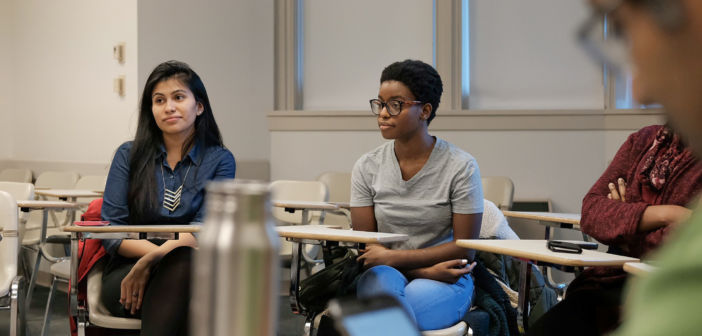As a young girl, Monica Moreno Figueroa was given simple advice from her grandmother: marry a man who had lighter skin than her to “improve” their family’s genealogy.
Moreno Figueroa says her experience with image and racial bias is common in her home country of Mexico. A lecturer in sociology at the University of Cambridge, Moreno Figueroa spoke in Williams Hall Monday about her research on institutionalized racism and the racialization of health and justice in Mexico.
Moreno Figueroa’s grandmother has blonde hair, blue eyes and fair skin. Moreno Figueroa, who has dark hair and a dark complexion, says she grew up thinking her grandmother was the ideal image of beauty.
“We don’t look like we come from the same family,” Moreno Figueroa said. “This is how it is in Mexico. One sister can have fair skin, and the other a dark complexion. This normalizes racism.”
As she matured, Moreno Figueroa said she began to question her grandmother’s words. This was no small feat, she said. It seemed talk of a “more beautiful” skin type was not limited to her house but was ingrained in some national practices in Mexico.
She said one practice is the class system.
“Lighter skin is thought of as richer,” Moreno Figueroa said. “It is a common thing to look to ‘improve’ the race. For example, don’t marry a dark man.”
Moreno Figueroa showed a video of children with two dolls, one white and one black. The children in the video were asked which was prettier, which was nicer, which they liked better and which they identified better with. Every time, the children picked the fair-skinned doll.
Moreno Figueroa said she uses this example to show how early young people in Mexico are taught to value light skin. Although there are no segregation laws in Mexico, the topic of race still makes people uncomfortable.
She said when comparing Mexico to the the United States, her home country’s racism isn’t as apparent. She attributes this to the dual ideologies surrounding race. Racial groups have historically been more geographically divided in the United States, while in Mexico they have been closely connected for centuries.
“Their racism versus our racism is so different,” attendee Carlos Padilla said. “We have pockets of people, therefore mixing groups takes individuals aback. In Mexico, that is normal.”
Although different racial groups in Mexico are more closely connected, the culture of racism and differentiation still remains. This ideology is rooted in the history of Mexico through mestizaje, the process of mixing ancestries, which is the foundation of Mexican society.
In the late 1700s, artists demonstrated these “mixings” through what are known as caste paintings. Moreno Figueroa showed several of these in her presentation, including “Spaniard and the Indian Women” and “Spaniard and the Black Woman.” She said in both paintings, the indigenous people are portrayed as violent and mean.
Moreno Figueroa described racism in her home country as having an intimate, dynamic and emotional impact on people. She said it seemed to put people into “little worlds” and allowed for limited personal advancement beyond the confines of race.
Kristen Mejia, ’17, said she was struck by the depth of the racial classifications under mestizaje. Moreno Figueroa provided a chart for each label: the mixing of a Spaniard and a mulatto makes a morisca and the mixing of an Indian and a torna atras makes a lobo.
The darker an individual is, the lower they are in the caste system, and there are more lighter labels than darker ones.
“They have a gradient of all different labels,” Mejia said. “It is crazy how in-depth they go.”
Moreno Figueroa dedicated her life to studying race because she said she wants to encourage other people to acknowledge racism and its implications in social justice.
Figueroa has been studying in Mexico since 2000 and has worked on a number of different projects. She described her work as “very emotional” and attended therapy as a result of the distress she witnessed during her research.
“I needed to talk about what was happening in the world,” Moreno Figueroa said. “I wanted to write about it and share it.”






Comment policy
Comments posted to The Brown and White website are reviewed by a moderator before being approved. Incendiary speech or harassing language, including comments targeted at individuals, may be deemed unacceptable and not published. Spam and other soliciting will also be declined.
The Brown and White also reserves the right to not publish entirely anonymous comments.
1 Comment
Stay out of the sun and you won’t get so dark……words I remember.